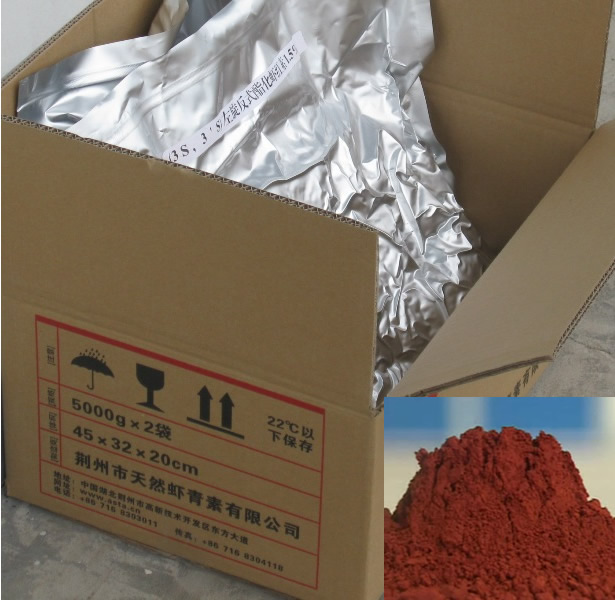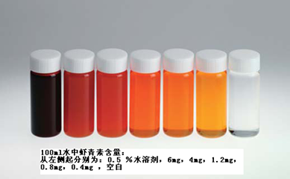|
Jingzhou Natural Astaxanthin Inc is a leading enterprise producing natural Astaxanthin by culturing heamotococcus pluvialis in China ,Asia.we were founded in 2003 to develop and commercialize microalgae-derived products for the aquatic feed & human food industry. Today,our company hold 32000㎡ culture area for heamotococcus pluvialis. We can supply high-quality food grade and feed grade natural astaxathin powder(1.5-3.0%)about 1.5Ton/month, And 5-10% Natural Astaxanthin oleoresin content &Natural Astaxanthin sofgel .

The process of Algal ASTAXANTHIN produce
We suggest you registered if you need our NaturAsta astaxanthin products in future.You may get harvest beyond you envision.
I register
For more information please Contact us directly:
A: Mr. Banghua zhang B:Ms. Kathy
Cell :0086-15827783667 Cell:0086-15872134419
Tel: 0086-716-8303507 Tel:0086-716-8303460
Fax: 0086-716-8304118 Fax:0086-716 8304118
E-mail:zhang_banghua@126.com Email:shaomin2002cn@126.com
MSN: banghua_zhang@msn.com Msn: shaomin2002cn@hotmail.com
SKYPE: kathyshao2002cn
OUR PRODUCTS:

·5% Natural Astaxanthin Oleoresin (oil) COA.pdf
·5% Natural Astaxanthin Oleoresin (oil) MSDS.pdf

Astaxanthin emulsion 0.5%
5% Natural Astaxanthin oil Looking for European | American | South-east Asia | Middle East | Russian |
South-Africa| Australian | south-American distributor!
1.Astaxanthin - a superb natural antioxidant
TABLE 1 - NATURAL SOURCES OF ASTAXANTH
TABLE 1
|
Astaxanthin natural source |
Astaxanthin concentration(ppm) |
|
Saimons |
5 |
|
plankton |
60 |
|
krill |
120 |
|
Arctic shrimp |
1200 |
|
Phaffia yeast |
8000
|
|
Haematococcus pluvialis |
40,000 |
The primary use of synthetic ASTAXANTHIN today is as an animal feed additive to impart coloration to salmonids (salmon and trout), as well as to red sea bream and tai. In natural habitats, salmonids obtain their coloration from natural food sources, including algae and crustaceans. However in fish farms, the absence of natural pigmentation sources results in salmonids with off-white coloration, imparting an artificial and unattractive look for consumers and making the fish difficult to market.
Today, essentially all commercial ASTAXANTHIN for aquaculture is produced synthetically from petrochemical sources, with an annual turnover of over $200 million, and a selling price of ~$2000 per kilo of pure ASTAXANTHIN.
Other developing applications for synthetic ASTAXANTHIN include poultry and egg production.
In recent years, there has been a growing trend toward using natural ingredients in all forms of food nutrients, resulting from increasing concerns for consumer safety and regulatory issues over the introduction of synthetic chemicals into the human food chain. This is also true for the nutraceutical and cosmeceutical markets.
Good examples of commercially important naturally derived carotenoids are beta-carotene, lycopene, lutein and zeaxanthin, commercial carotenoids with antioxidant properties which have become popular ingredients in many vitamin and mineral supplements. Beta-carotene and lycopene can be produced both synthetically (from petrochemicals) and naturally. A decade ago, natural beta-carotene accounted for a tiny percentage of the total world market. Since then, that market has increased several-fold and today, natural beta-carotene accounts for 20 to 25% of world demand. Virtually all nutraceutical producers use natural rather than synthetic carotenoids, and pay premium prices as much as five times that of the synthetic product.
The demand for natural ASTAXANTHIN is now emerging in the multi-billion dollar nutraceutical market, and increasingly, medical researchers believe that ASTAXANTHIN may have significant pharmaceutical applications. While only a negligible part of today's market, the demand for such applications is expected to grow significantly in the near term as a result of numerous medical studies performed during the last 5 years in the area of ASTAXANTHIN applications.
More and more research supports the conviction that a daily dose of ~5 mg of ASTAXANTHIN is of tremendous importance for health management, by protecting cells and body tissues from the oxidative stress caused by free radicals, among others.
ASTAXANTHIN producers have conducted several studies in recent years to demonstrate the safety of natural ASTAXANTHIN derived from Haematococcus A randomized, double-blind, placebo-controlled, 8-week trial designed to determine the safety of ASTAXANTHIN in 35 healthy adults was published recently Results revealed that healthy adults can safely consume 6 mg of ASTAXANTHIN per day from Haematococcus pluvialis algal extract.
Based on recent findings, we believe that a daily dose of ASTAXANTHIN will have an important influence in preventing a broad array of age related diseases. Moreover, small daily doses of ASTAXANTHIN may prevent or delay the onset of some diseases, thus saving society significant sums of money.
2.NATURAL vs. SYNTHETIC ASTAXANTHIN (best for salmon & trout)
3.The best enhance aquatic animal color additive.
|